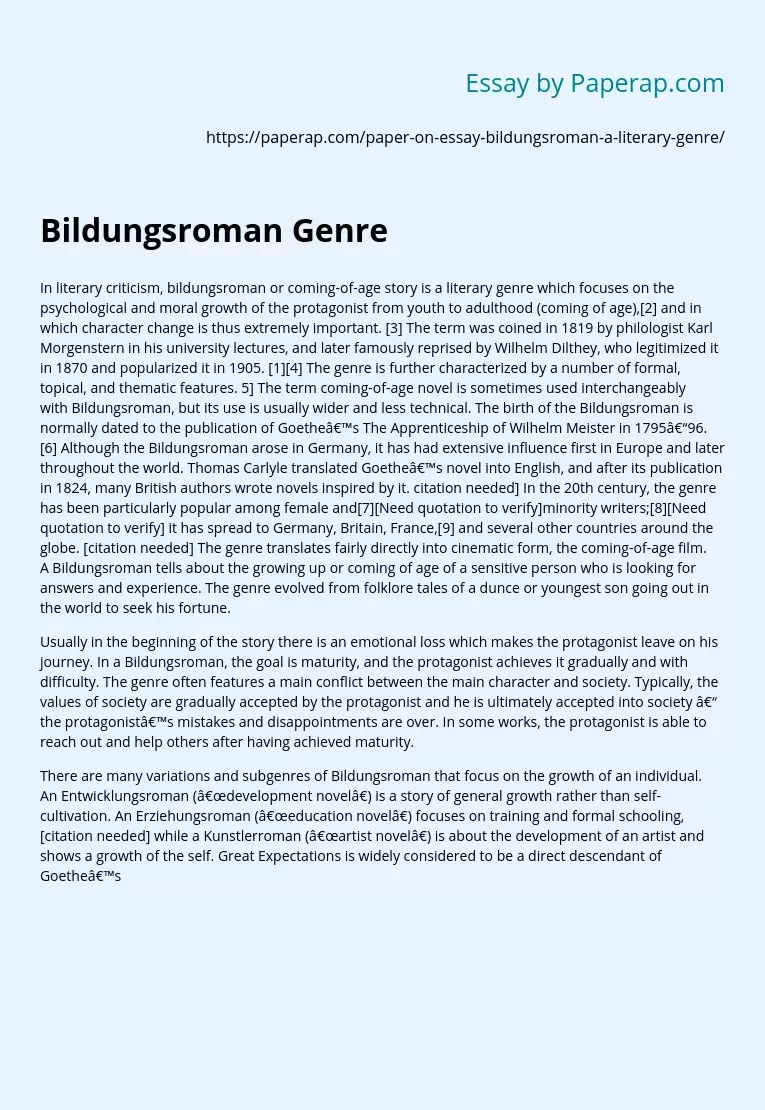Bildungsroman Genre
In literary criticism, bildungsroman or coming-of-age story is a literary genre which focuses on the psychological and moral growth of the protagonist from youth to adulthood (coming of age),[2] and in which character change is thus extremely important. [3] The term was coined in 1819 by philologist Karl Morgenstern in his university lectures, and later famously reprised by Wilhelm Dilthey, who legitimized it in 1870 and popularized it in 1905. [1][4] The genre is further characterized by a number of formal, topical, and thematic features.
5] The term coming-of-age novel is sometimes used interchangeably with Bildungsroman, but its use is usually wider and less technical. The birth of the Bildungsroman is normally dated to the publication of Goethe’s The Apprenticeship of Wilhelm Meister in 1795–96. [6] Although the Bildungsroman arose in Germany, it has had extensive influence first in Europe and later throughout the world. Thomas Carlyle translated Goethe’s novel into English, and after its publication in 1824, many British authors wrote novels inspired by it.
citation needed] In the 20th century, the genre has been particularly popular among female and[7][Need quotation to verify]minority writers;[8][Need quotation to verify] it has spread to Germany, Britain, France,[9] and several other countries around the globe. [citation needed] The genre translates fairly directly into cinematic form, the coming-of-age film. A Bildungsroman tells about the growing up or coming of age of a sensitive person who is looking for answers and experience.
The genre evolved from folklore tales of a dunce or youngest son going out in the world to seek his fortune.
Usually in the beginning of the story there is an emotional loss which makes the protagonist leave on his journey. In a Bildungsroman, the goal is maturity, and the protagonist achieves it gradually and with difficulty. The genre often features a main conflict between the main character and society. Typically, the values of society are gradually accepted by the protagonist and he is ultimately accepted into society – the protagonist’s mistakes and disappointments are over. In some works, the protagonist is able to reach out and help others after having achieved maturity.
There are many variations and subgenres of Bildungsroman that focus on the growth of an individual. An Entwicklungsroman (“development novel”) is a story of general growth rather than self-cultivation. An Erziehungsroman (“education novel”) focuses on training and formal schooling,[citation needed] while a Kunstlerroman (“artist novel”) is about the development of an artist and shows a growth of the self. Great Expectations is widely considered to be a direct descendant of Goethe’s Wilhelm Meister, the prototypicalBildungsroman.
Tom Jones As A Bildungsroman Novel
Aurora Leigh takes the genre and complicates it with problems of gender in Victorian society. Waterlandreconsiders personal growth in a postmodern context, using narrative not for description, but rather as the vehicle for maturation * Hayy ibn Yaqdhan, by Ibn Tufail (12th century), a precursor of the genre[11] * The History of Tom Jones, a Foundling, by Henry Fielding (1749)[12] * The Life and Opinions of Tristram Shandy, Gentleman, by Laurence Sterne (1759)[12] * Candide, by Voltaire (1759)[13] Emile: or, On Education, by Jean-Jacques Rousseau (1762) * Wilhelm Meister’s Apprenticeship, by Johann Wolfgang von Goethe, the paragon of the genre (1795–96) * The Sorrows of Young Werther, by Johann Wolfgang von Goethe (1787), though the protagonist doesn’t learn to accept society, and instead commits suicide. * The Swiss Family Robinson (German: Der Schweizerische Robinson), by Johann David Wyss, and edited by his son Johann Rudolf Wyss (1812) * Jane Eyre, by Charlotte Bronte (1847
Bildungsroman Genre. (2019, Dec 05). Retrieved from https://paperap.com/paper-on-essay-bildungsroman-a-literary-genre/

